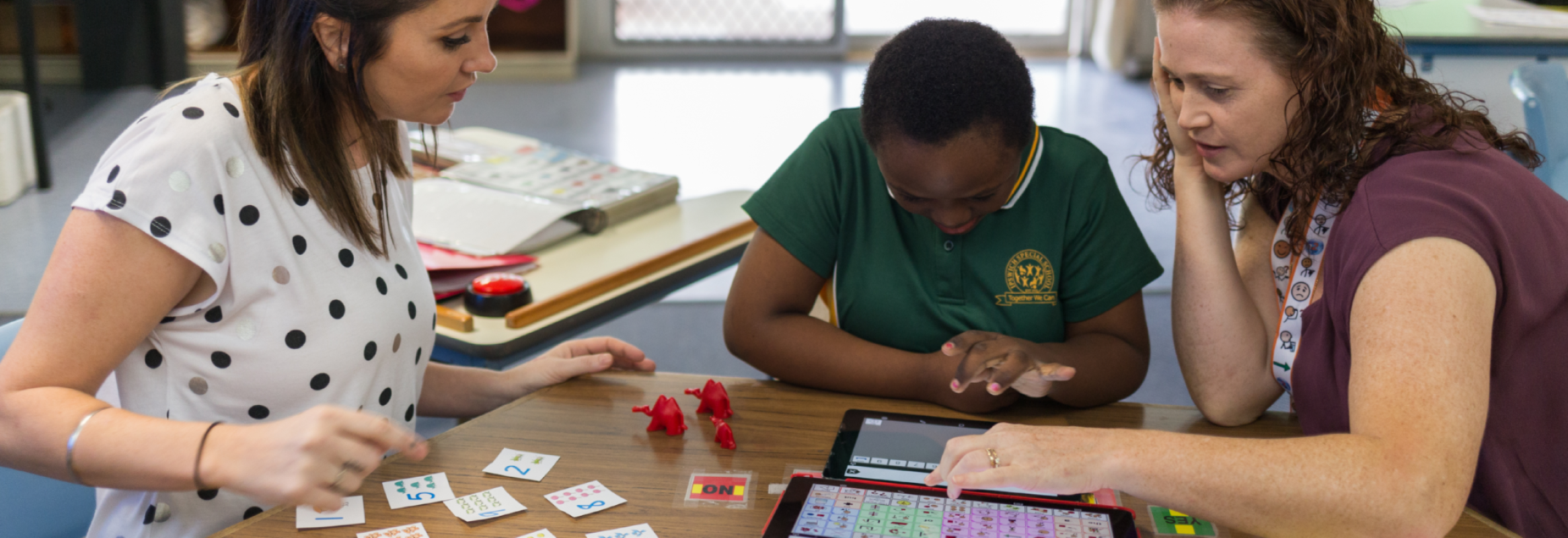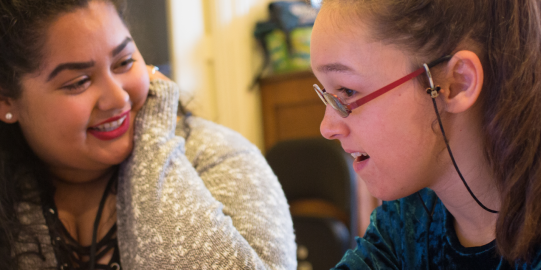Everyone is busy. Everyone has different things that they are juggling. While your AAC team might be sending chats, emails, or photos, it is important to carve out time to sit and meet together.
Making time for AAC team meetings can build collaborative relationships. It can allow for creative problem-solving and enable teams to get on the same page. Whether you meet face-to-face or online, make time to meet regularly. Ensuring these meetings are collaborative and respectful to everyone on the team is important. Here are seven tips to have successful AAC team meetings.
1. Clarify who is on the AAC team and who needs to attend each meeting
Take time to decide who should be included in each team meeting. The AAC user themselves is the central member of the team. As such, they should always be invited and encouraged to participate as much as possible. Some AAC teams might be smaller, with just the parent, educator, and speech therapist. Others may be larger, including paraprofessionals, administrators, AT specialists, behavior therapists, and occupational therapists. Some meetings need everyone. Other times, a few key people meet to address a specific issue.
Also, who will be the one to organize the meetings? Every team needs someone to take the lead in arranging when and where you meet.
2. Set the meeting and agenda
Choose a time and a location that works for everyone on the team. Make sure you set enough time to allow for discussion and for everyone to have a chance to participate. To avoid feeling rushed, pick a time when everyone has buffer time in case the meeting takes longer than anticipated. Before the meeting, discuss on your normal communication channel: What are the goals of the meeting? What do you want to discuss? What issues need to be resolved? Set an agenda before the meeting. This way, everyone can prepare and knows what to expect. If you are unsure what to discuss, look at our for ideas.
Download AAC team meeting template
3. Gather information for your meeting.
Now that you know the agenda for the meeting, think about what information you need to bring with you. Are there any articles or research you have read lately that you want to discuss with the rest of the team? Is there something happening with the AAC user you want to discuss? Bring all the documentation or even photos and videos you have.
Remember, the AssistiveWare Support team can always recommend research and articles on different topics. There is lots of evidence about AAC best practice, but you don’t know what you don’t know. Share what you find with the AAC team to help develop a common understanding.
Talk about the meeting with the AAC user in advance. Make sure to check if there is something they would like to contribute or share with the rest of the team.
4. Respect each team member and their experiences.
Remember that everyone on the team is an expert in their own way. Listening to all voices on the team and respecting one another’s opinion (even if it may be different from yours) is a great first step to all team members feeling included and valued.
Learn more about different team members’ thoughts and experiences by reading blogs written by teachers, Speech Pathologists, parents, and AAC users about working together in an AAC team.
5. Work towards a common understanding
Start meetings by sharing stories and celebrating successes. This is a positive way to get underway.
Next, team members can share any updates. If there are common problems, brainstorm with the team. How can you work on the problem together? Get everybody’s ideas out there. All ideas are valid.
If someone makes a claim, don’t just disagree. Ask for evidence.
Bring evidence with you to the meeting. For example: If you know that you will want to say, “The child needs access to multiple communication functions,” then you need to be ready to back that up with evidence.
If someone says, “They aren’t ready for AAC,” that must be backed up. Be prepared to ask for evidence and examples rather than ignoring someone’s concerns. It is ok to question and discuss assumptions. Then figure out how you can work on these things together.
When people are included in the problem-solving process, they will be more invested in the solution. Decide which problem points are urgent and need a solution immediately. Then discuss which are long-term and can be worked on slowly over time. It’s important to solve today’s communication problems while building the skills to address problems in the future.
6. Take notes and agree on the next steps
Take notes during the meeting. You can use our AAC team meeting template. During the meeting, decide on the next steps moving forward. Make sure everyone understands and feels confident about what they need to do moving forward. Document the steps, and share them with all members of the AAC team so everyone has a copy they can refer back to. You should ask everyone to sign the plan. Agree to follow through and try to do what you agreed to together. Don’t give up to soon; follow the next steps for the agreed-upon length of time. This could be 6-12 months. After all, AAC takes time. Below the meeting ends, make sure to schedule the next time you will all meet.
7. Stay in contact after the meeting
Have the team agree on how to stay in touch between meetings. Perhaps emails or group messenger would work. Make to check in and regularly share what is working and what isn’t working with the team. Discuss and problem-solve any challenges while taking time to celebrate the successes the whole AAC team is having.





